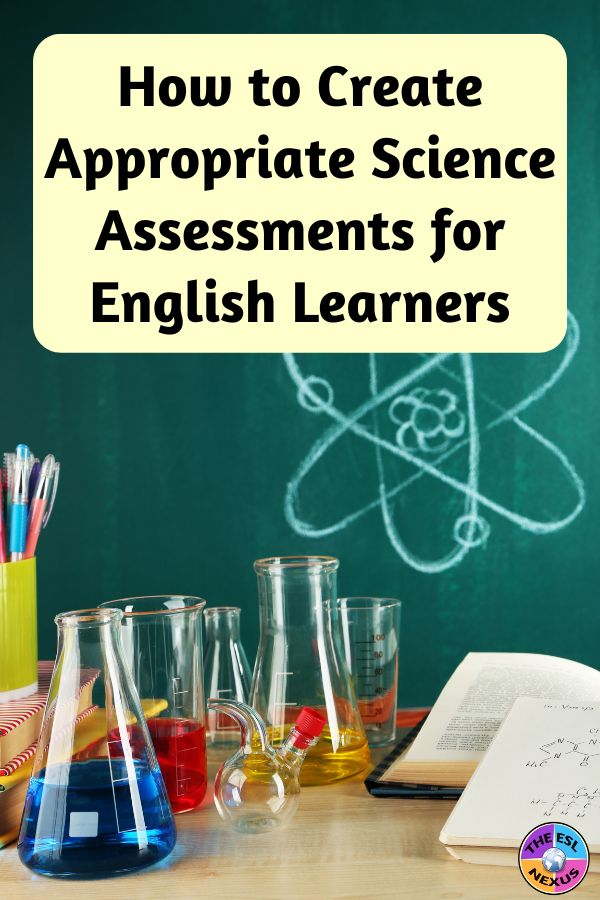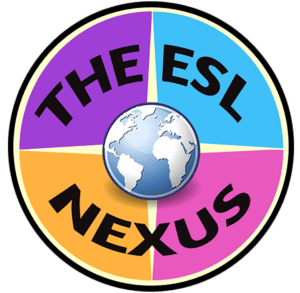Teaching Science to English Language Learners is easier, in my opinion, than teaching Social Studies because it is less language-dependent and more hands-on. Nevertheless, there is a lot of science terminology that Multilingual Learners of English must learn as well as certain text structures that are commonly used in science textbooks. To ensure that they’re assessed on their knowledge of science and not on their knowledge of English, I’m going to share 4 tips for creating appropriate science assessments for ELLs and then give examples for students at different levels of language proficiency.
 |
| Find Science resources HERE; graphic created by The ESL Nexus |
Tips for Creating Appropriate Science Assessments for English Learners
1) Use Visuals
Some Multilingual Learners of English may understand the concepts but not yet be able to use all the science vocabulary needed to explain those ideas. Giving a photo or diagram to students and asking them to label, caption, or list info instead of writing sentences lets students demonstrate their understanding without testing their knowledge of English. Visuals also help ELLs determine what is actually being assessed because, assuming they know the material, they are more likely to recognize the images than the words, especially if they are at lower levels of language proficiency.
2) Offer Sentence Frames and Word Banks
Providing this type of scaffolding lessens the language load on students. Sentence frames aid students when writing responses to questions and help MLEs organize what to say. Word banks give students the target vocabulary needed to answer questions or do tasks, which also lets them focus more on getting the answers right than on trying to decide which words to use.
3) Let Students Draw Pictures, Create Models, and Do Experiments
Creating 2-D and 3-D examples of scientific concepts allows students at all levels of language proficiency to demonstrate what they’ve learned while minimizing the amount of English needed to explain concepts. Giving students the chance to show their learning through hands-on activities and projects often mirrors the way scientific concepts were taught so it makes sense to assess them that way, too.
4) Use Oral Assessments
For many English Learners, it is easier to express themselves orally than in writing. Even if their grammar is not completely accurate, they can get their ideas across more effectively when speaking than when writing. So letting MLEs orally explain concepts instead of responding in writing can be a more accurate way of determining how well they have learned the materials.
Examples of Appropriate Science Assessments for Multilingual Learners of English
For Beginning ELLs
Elementary
The assessment is to label the parts of a plant. At the top of a page, include a word bank with the target terms students have been taught; for example, roots, stem, leaves, and flower. Underneath, display pictures of the different parts of a plant. Students use the word bank words to correctly label the individual parts of the plant.
Middle School
The assessment is to identify things that are in different states of matter. At the top of a page, type the words solid, liquid, and gas. Underneath, show 2 photographs for each state of matter; for example, an ice cube and hail, a glass of water and a stream, a teapot of boiling water and a railroad engine with steam coming out of it. Students label each photo with the correct state of matter it represents.
For Intermediate ELLs
Elementary
The assessment is to demonstrate knowledge of the parts of a plant. In the top half of a page, show a plant with each part – roots, stem, leaves, flowers – already labeled. Underneath, give sentence frames that describe the functions of each plant part. Students complete the sentence frames with their own words. For example:
Roots help plants because they __________.
Plants use stems to __________ and __________.
Leaves are important because they __________.
Plants have flowers because __________.
Middle School
The assessment is to describe the 3 states of matter. On a page, create a table with 4 columns and 4 rows and title it States of Matter. In the first column, leave the first cell blank and in the cells below write Solid, Liquid, Gas. In the second column, write Properties in the top cell, in the third column, write Examples in the top cell, and in the 4th column, write Changes. Tell students to complete the table by writing information about each criteria; for the Changes column, tell them to describe what happens when each state of matter changes to a different state.
For Advanced ELLs
Elementary
The assessment is for students to orally describe the characteristics and functions of the parts of a plant. Create a list of guided prompts and questions, such as: Where are the roots of a plant located? What are the purposes of plant roots? What else can you tell me about roots? Use similar questions for the other parts of a plant. You can tell students to include target vocab words in their answers as well, if you wish. You can ask students individually face-to-face or you can have them record responses on devices if they all have access to them.
Middle School
The assessment is to do an experiment that lets students show they understand what the 3 states of matter are and that they can use relevant scientific terms correctly. Put students in small groups and give each group something that is a solid, a liquid, and a gas. Tell students to take a few minutes to observe each thing, then record their observations, write how they collected their data and their analysis of the data, and what their conclusions are. You can give students target vocabulary words to use when writing, if you wish. Then tell students to write a description of the activity and summarize their findings.
Wrap Up
If you need a textbook that is accessible to ELLs, I used Access Science, published by Great Source, with my middle school students and thought it explained concepts clearly. The first chapter is about the scientific method, then there are 7 units for Earth Science, 8 units for Life Science, and 8 units for Physical Science. Each unit contains 3 or 4 chapters. Chapters are filled with color pictures, tasks to develop language skills, and vocabulary terms that are explained at the bottom of pages as well as in a glossary at the end of the book. (This is an affiliate link. That means that I make
a small commission if you purchase the book but it’s at no additional
cost to you. Thank you for your support!)
I hope these tips and examples for creating appropriate science assessments for English Learners give you some ideas you can use with your students. This blog post is the last in my series about creating appropriate subject-area assessments for Multilingual Learners of English. Previous posts in this series were about creating Math Assessments, Social Studies Assessments, and Assessments for Reading, Vocabulary, and Writing.




